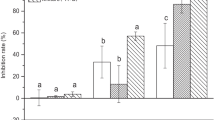Abstract
Vampirovibrio chlorellavorus is a predatory and parasitic bacterium that thoroughly overtakes strains of Chlorella sorokiniana through attachment to the cell wall. Prior work has shown that many freshwater strains of C. sorokiniana become readily infected with this bacterium. However, saltwater strains of C. sorokiniana have not yet been tested for susceptibility to infection of V. chlorellavorus. The purpose of this study was to investigate the ability of V. chlorellavorus to infect two marine strains of C. sorokiniana: DOE 1116 and DOE 1044. These results are compared to C. sorokiniana DOE 1412 grown in both freshwater and saltwater environments. Laboratory-scale culture replicates of C. sorokiniana DOE 1412, 1116, and 1044 in different freshwater and saltwater media were infected with V. chlorellavorus and compared to uninfected cultures grown under the same conditions. Optical density, pulse amplitude modulation (PAM) fluorometry, and light microscopy measurements were performed to assess culture health over a 2-week period. Light and temperature remained constant throughout the course of the experiment. Microscopy results displayed clear infection of all strains of infected replicates. Further evidence for infection was provided by lower growth rates in infected cultures versus control cultures as measured by absorbance at 750 nm. Additionally, lower growth rate was observed overall for uninfected cultures of C. sorokiniana DOE 1412 in saltwater medium. PAM fluorimetry showed slightly lower values for the maximum photosynthetic efficiency in infected cultures but the results were not statistically different than the controls. C. sorokiniana DOE 1412 is known to be susceptible to V. chlorellavorus infection in freshwater medium, BG11. Using this model system for V. chlorellavorus infection, our results show clear evidence of V. chlorellavorus infection in the two marine strains, C. sorokiniana 1116 and 1044.


Similar content being viewed by others
Availability of data and material
The datasets generated during and/or analyzed during the current study are available from the corresponding author on reasonable request.
References
Coder DM, Goff LJ (1986) The host range of the chlorellevorus bacterium (“Vampirovibrio chlorellavorus”). J Phycol 22:543–546
Coder DM, Starr MP (1978) Antagonistic association of the chlorellavorus bacterium (“Bdellovibrio” chlorellavorus) with Chlorella vulgaris. Curr Microbiol 1:59–64
Gromov BV, Mamkaeva KA (1972) Electron microscopic study of parasitism by Bdellovibrio chlorellavorus bacteria on cells of the green alga Chlorella vulgaris. Tsitologiia 14:256–260
Li X (2015) Effect of temperature and salt on laboratory growth and pathogenicity of Vampirovibrio chlorellavorus and killing of a cultivated Chlorella host. Masters Thesis, University of Arizona, Tucson, Arizona
Park S-H, Steichen SA, Li X, Ogden K, Brown JK (2019) Association of Vampirovibrio chlorellavorus with decline and death of Chlorella sorokiniana in outdoor reactors. J Appl Phycol 31:1131–1142
Schreiber U, Bilger W, Neubauer C (1995) Chlorophyll fluorescence as a nonintrusive indicator for rapid assessment of in vivo photosynthesis. In: Schulze ED, Caldwell MM (eds) Ecophysiology of Photosynthesis. Springer, Berlin, pp 49–70
Schreiber U (2004) Pulse-Amplitude-Modulation (PAM) fluorometry and saturation pulse method: an overview. In: Papageorgiou GC, Govindjee (eds) Chlorophyll a Fluorescence. Advances in Photosynthesis and Respiration, vol 19. Springer, Dordrecht, pp 279–319
Soo RM, Woodcroft BJ, Parks DH, Tyson GW, Hugenholtz P (2015) Back from the dead; the curious tale of the predatory cyanobacterium Vampirovibrio chlorellavorus. PeerJ 3:e968
Steichen SA, Brown JK (2019) Real-time quantitative detection of Vampirovibrio chlorellavorus, an obligate bacterial pathogen of Chlorella sorokiniana. J Appl Phycol 31:1117–1129
Acknowledgements
The authors thank Dr. Judy Brown at University of Arizona for her generous gift of Vampirovibrio chlorellavorus and Scott Edmundson at Pacific Northwest National Laboratories for their contributions of C. sorokiniana DOE 1116 and 1044. This work was completely funded by BioEnergy Technologies Office (BETO) through the DISCOVR project (NL0032356). Sandia National Laboratories is a multi-mission laboratory managed and operated by the National Technology & Engineering Solutions of Sandia, LLC, a wholly owned subsidiary of Honeywell International Inc., for the U.S. Department of Energy’s National Nuclear Security Administration under contract DE-NA0003525. This paper describes objective technical results and analysis. Any subjective views or opinions that might be expressed in the paper do not necessarily represent the views of the U.S. Department of Energy or the United States Government.
Funding
This work was completely funded by BioEnergy Technologies Office (BETO) through the DISCOVR project (NL0032356).
Author information
Authors and Affiliations
Contributions
LCA: acquisition of data, methodology, experimental design, analysis and interpretation, writing-original draft, writing-review & editing. DM: experimental design, writing-review and editing, supervision. TH: acquisition of data, analysis and interpretation, writing-review and editing. JAT: project administration, conceptualization, experimental design, writing-review and editing, resources, validation, supervision, funding acquisition.
Corresponding author
Additional information
Publisher's note
Springer Nature remains neutral with regard to jurisdictional claims in published maps and institutional affiliations.
Supplementary Information
Below is the link to the electronic supplementary material.
Rights and permissions
About this article
Cite this article
Atencio, L.C., Maes, D., Hipple, T. et al. Susceptibility of two saltwater strains of Chlorella sorokiniana to Vampirovibrio chlorellavorus. J Appl Phycol 34, 81–87 (2022). https://doi.org/10.1007/s10811-021-02602-0
Received:
Revised:
Accepted:
Published:
Issue Date:
DOI: https://doi.org/10.1007/s10811-021-02602-0




